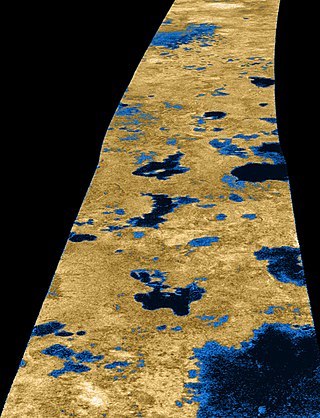
Lake Nemi is a small circular volcanic lake in the Lazio region of Italy 30 km (19 mi) south of Rome, taking its name from Nemi, the largest town in the area, that overlooks it from a height.

Lake Albano is a small volcanic crater lake in the Alban Hills of Lazio, at the foot of Monte Cavo, 20 km (12 mi) southeast of Rome. Castel Gandolfo, overlooking the lake, is the site of the Papal Palace of Castel Gandolfo.

Ontario Lacus is a lake composed of methane, ethane and propane near the south pole of Saturn's moon Titan. Its character as a hydrocarbon lake was confirmed by observations from the Cassini spacecraft, published in the 31 July 2008 edition of Nature. Ontario Lacus has a surface area of about 15,000 square kilometers (5,800 sq mi), about 20% smaller than its terrestrial namesake, Lake Ontario in North America. In April 2012, it was announced that it may be more like a mudflat or salt pan.
The Latin word lacus means "opening, hole, pool, lake," and was also the word for a distribution point in the public water supply of ancient Rome. It can refer to:

Lakes of ethane and methane on Titan, Saturn's largest moon, have been detected by the Cassini–Huygens space probe, and had been suspected long before. The large ones are known as maria (seas) and the small ones as lacūs (lakes).

Jingpo Lacus is a lake in the north polar region of Titan, the planet Saturn's largest moon. It and similarly sized Ontario Lacus are the largest known bodies of liquid on Titan after the three maria. It is composed of liquid hydrocarbons. It is west of Kraken Mare at 73° N, 336° W, roughly 240 km long, similar to the length of Lake Onega on Earth. Its namesake is Jingpo Lake, a lake in China.

Mackay Lacus is the seventh largest of a number of hydrocarbon seas and lakes found on Saturn's largest moon, Titan. The lake is composed of liquid methane and ethane, and was detected by the Cassini space probe.

Abaya Lacus is one of a number of hydrocarbon lakes found on Saturn's largest moon, Titan.

Bolsena Lacus is one of a number of hydrocarbon lakes found on Saturn's largest moon, Titan.

Neagh Lacus is one of a number of hydrocarbon lakes found on Saturn's largest moon, Titan. The lake is composed of liquid methane and ethane, and was detected by the Cassini space probe.

Sotonera Lacus is one of a number of hydrocarbon lakes found on Saturn's largest moon, Titan.

Hammar Lacus is one of a number of hydrocarbon seas and lakes found on Saturn's largest moon, Titan.

Feia Lacus is one of a number of hydrocarbon seas and lakes found on Saturn's largest moon, Titan. It was named in 2007 on the basis of data taken by the space probe Cassini.

Koitere Lacus is one of a number of hydrocarbon lakes found on Saturn's largest moon, Titan. The lake is composed of liquid methane and ethane, and was detected by the space probe Cassini.

Müggel Lacus is one of a number of hydrocarbon seas and lakes found on Saturn's largest moon, Titan.

Ladoga Lacus is a geographical feature on Saturn's largest moon, Titan, named after Lake Ladoga, Russia. It is one of a number of "methane lakes" found in Titan's north polar region.

Sionascaig Lacus is one of a number of hydrocarbon seas and lakes found on Saturn's largest moon, Titan. The lake is located at latitude 41.52°S and longitude 278.12°W on Titan's globe, and is composed of liquid methane and ethane. The feature is named for the Earth lake, Loch Sionascaig, in Scotland.

Kivu Lacus is a small Titanean hydrocarbon lake. It was discovered by the Cassini probe. The lake is near Titan's north pole and is named after Lake Kivu in the Democratic Republic of Congo and Rwanda. In 2012, Cassini spotted an Infrared glint off the lake. The aspects of it suggested waves.












